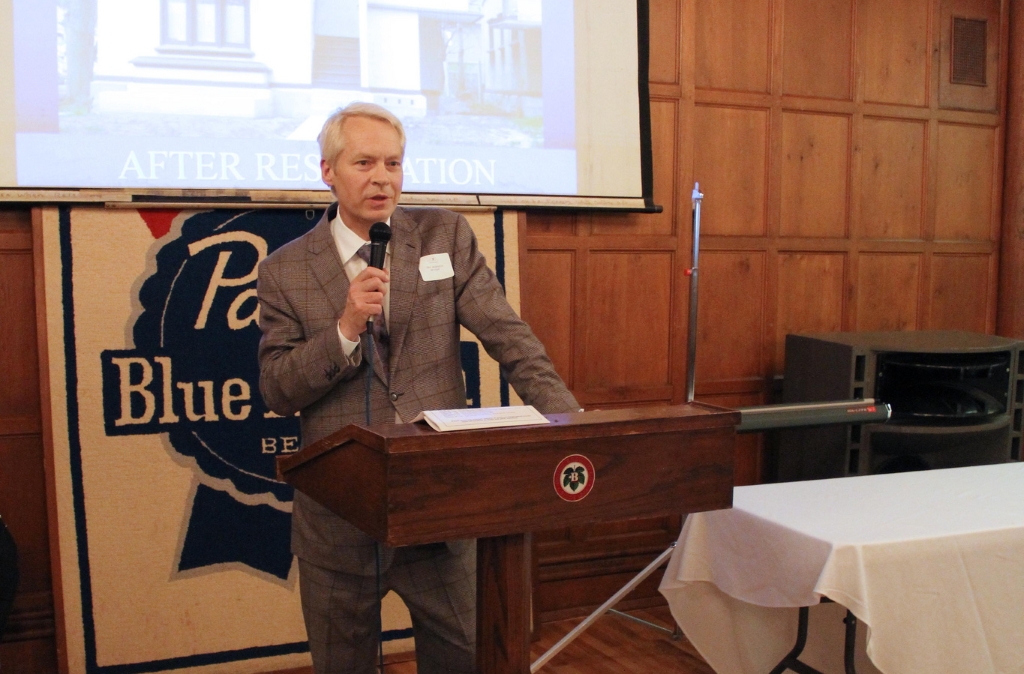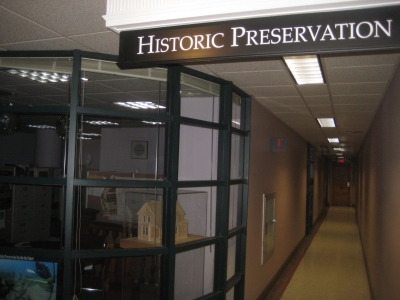The Legacy of Paul Jakubovich
The City’s Historic Preservation Officer had an unmatched knowledge of and commitment to the preservation of historic buildings.
The City of Milwaukee Historic Preservation office has always been a quiet place, but today, the room appropriately located in suite B-4 of City Hall is closed, with the lights off. On December 22nd, 2014, Paul Jakubovich, the city’s Historic Preservation Coordinator, died of complications of kidney disease at 57.
The man’s involvement with the historic fabric of this city was complete, as was his dedication to his job, despite his failing health, about which I knew nothing. As it turns out, Jakubovich had suffered from kidney disease for years and was reliant on dialysis to stay alive. Kidney ailments can be particularly cruel, with peaks and valleys, often on a downward baseline, sapping the strength of the sufferer. The end, as in this case, can come suddenly.
Just a week earlier I had visited him in his office, which is filled with filing cabinets, as might be expected, along with some unexpected items like an architect’s drawing board, and three-dimensional samples of historically appropriate building details, customized for the Milwaukee market.
The drawing board was an active working surface for Jakubovich, who used a T-square, compass, straightedge and other classic draftsman’s tools to create elegant renderings of those building details, which he would then construct himself for demonstration purposes.
Holding a cutaway model in their hands could help owners of historic properties visualize construction details and the means necessary to make appropriate repairs and renovations.
I had visited for the purpose of finding some information that had proved elusive about a House Confidential property I was researching. Paul pulled out the needed document from one of the file cabinets, and even highlighted the relevant passages for me.
His commitment to the city’s preservation started early; Jakubovich’s work includes photographs of buildings taken while he must have been in his teens and early twenties. He was the principal author, in 1988, of the “Lower East Side Neighborhood Historic Resources Survey,” which documented the history and helped pave the way for restoration of the Brady Street area. That report, which has not been digitized, contained the information I had been looking for. When Jakubovich handed me the highlighted copy of the report I needed, he never mentioned that he was the author.
In addition to that study, Jakubovich also wrote three historic preservation guidebooks published by the Department of City Development. These were lavishly illustrated with his own photographs and architectural drawings.
In his foreword to Good for Business: a Guide to Rehabilitating the Exteriors of Older Commercial Buildings, (1995), Jakubovich argues for the value of preserving old storefronts using language a developer could appreciate:
“…Today, intact historic architectural character is a marketable asset in Milwaukee’s older neighborhoods. In fact, many people will pay more for a well-maintained older commercial structure that has been returned to its original exterior features than they will for a ‘modernized’ older building that has a tacky modern storefront and has been stripped of its cornices, ornamentation, and original storefront.”
Jakubovich wrote that it was his hope that:
“the architectural integrity and old world craftsmanship of Milwaukee’s older commercial buildings will no longer be needlessly lost in the name of improvement.”
Not only did Jakubovich seek to preserve old buildings, he wished to restore them — and the streets they were on — to their original fabric. His “before” photographs showed buildings with fabulous detail, contrasted with “after” photographs of the same structures stripped of their ornamentation and character. With his help, some of those buildings have been “re-aftered” or “befored,” and now resemble their original iteration.
As he wrote in the foreword to As Good as New: A Guide to Renovating the Exterior of Your Older Home, (1993):
“Milwaukee has lost almost as much of its valuable architectural heritage to bad renovation as it has to demolition.”
But Jakubovich was not an academic theorist mourning the sad state of renovation practices from his period-appropriate ivory tower. Instead, he deployed his great knowledge of historic building practices and techniques into practical lessons in Living with History: a Guide to the Preservation Standards to Historically Designated Houses in Milwaukee (1997). This book was aimed at owners of historic homes in Milwaukee. Many of the owners were eager to maintain the historic nature of their buildings, but lacked resources to do so.
In most cities, a historic preservation officer might point the owners in the direction of standard reference works on, say, Queen Anne houses.
![[R] Paul Jakubovich at Historic Milwaukee's Remarkable Milwaukee event on February 27th, 2014. Photo by Grace Fuhr.](https://urbanmilwaukee.com/wp-content/uploads/2014/12/PaulJ400.jpg)
[R] Paul Jakubovich at Historic Milwaukee’s Remarkable Milwaukee event on February 27th, 2014. Photo by Grace Fuhr.
Instead, readers in Milwaukee got specific instructions particularly adapted to local circumstances and construction practices.
The book is laden with Jakubovich’s photographs and illustrations of building elements and types. It shows best (and worst) practices for repair and restoration of frame, stucco, brick and veneer construction. The book includes pages illustrating “NO!” and “YES!” approaches to building restoration.
I haven’t found a comparable source for any other city in the country. Nowhere else can you find such comprehensive, localized, guides for going from the abstract to the concrete.
In fact, when it came to cementitious building materials, Jakubovich was an expert. As City Clerk Jim Owczarski wrote to me:
“[Paul] taught me about the consistency of mortar — my own grandfather was a stone mason and I never found this out — and how it’s rated on a hardness standard based on the letters in the word MASONWORK.
“One thing you didn’t know if you didn’t work closely with him was his trade knowledge. I never had the opportunity to ask where he picked it up, but he knew a great deal about windows, doors, porches, basements, and everything else construction related. … This mattered particularly when trying to find his way to “yes” with those engaged in restoration projects. Many times I saw him tell an applicant for a certificate of appropriateness that there was no way the Commission would approve what was being proposed, but if he or she would only do a very specific thing matters could go forward. More often than not, at least in my experience, the applicants didn’t know the best way forward until Paul suggested it to them.”
Owczarski began working closely with Jakubovich after 2009 when the Historic Preservation staff of two (Jakubovich and Carlen Hatala) was reassigned to his office after years of being part of the Department of City Development.
Aldermen Bob Bauman, Nik Kovac and Tony Zielinski, whose districts include some of the city’s oldest neighborhoods, championed the measure to remove the historians from oversight by officials at DCD.
Owczarski came to have great respect for his colleague, who was now somewhat insulated from the profit-first demands of developers. The new spot at the clerk’s office gave Jakubovich a chance to look at the big picture, Owczarski said.
“I sometimes wondered if Paul — for all his constant attention to the current built environment of the community — didn’t sometimes look out over the landscape and see a vista of lost things. We spoke often of the Pabst Building, the Plankinton Mansion, the railroad station, &c., but also of things as small as the Lustron homes that are slowly disappearing. He took those losses personally. I think it was concern over trying to prevent future losses that drove him to attend as many community meetings, planning sessions, and neighborhood get-togethers hoping to convince just the right people that preservation could be an option in circumstances where developers didn’t see it that way.”
Jakubovich died a year and two days after Donna Schlieman, a historic preservation activist whom he eulogized in a story I wrote for Urban Milwaukee announcing her death.
In May, 2014, the Jakubovich 1927 Tudor home in Washington Heights was selected for a House Confidential story. And Jakubovich was chosen to receive an award in 2014 from Historic Milwaukee, Inc., recognizing his lifetime commitment to the city’s historic built environment.
As Owczarski put it, expressing a sentiment many would feel: “I shall miss him.”
Political Contributions Tracker
Displaying political contributions between people mentioned in this story. Learn more.
- September 4, 2014 - Robert Bauman received $150 from Paul Jakubovich
Plenty of Horne
-
Milwaukee Modernism Gains National Awards
 Dec 15th, 2025 by Michael Horne
Dec 15th, 2025 by Michael Horne
-
New Rainbow Crosswalks Mark Milwaukee’s LGBTQ+ History
 Oct 8th, 2025 by Michael Horne
Oct 8th, 2025 by Michael Horne
-
Welcome Back, Tripoli Country Club!
 May 27th, 2025 by Michael Horne
May 27th, 2025 by Michael Horne
























Paul was a stellar friend and colleague. His contribution to his work, friends, and family will be sadly missed.
I had only stopped in his office once, to ask some inane building question, and was led on a hour journey into the nuances of a dozen Milwaukee historic gems of architecture. I was intrigued and amazed at his detail and passion throughout the entire conversation. I can only imagine the void he has left behind. I’m sure he will be sadly missed.
Thank you for this fine tribute to Paul and his legacy. At lunchtime this week I crossed Water at Kilbourn and glanced up with the sudden impression that I saw Paul’s figure at the City Hall entrance…I had once asked Paul if he knew of any stories about ghosts haunting City Hall. We did not find any convincing tales at the time. I realize now that Paul’s spirit and presence will alwayls be felt at City Hall and and infusing the entire City.
A life well lived. A good man gone too soon.
I knew Paul back when he was an undergraduate at UWM, studying journalism. He certainly put those skills to work in all the books he wrote. He had a yearning to study architecture at that time, but didn’t know how to chart a pathway. Well, he found a way to pull all his talents and ideas to use. I lost touch with him over the years. It is good to see how much he accomplished in his life. Thank you for this article
As a colleague of mine at the city, he was a walking encyclopedia on historic preservation and had the design/build expertise to coach people in the nuts and bolts of restoration–or the bricks and mortar, the brackets and balusters, etc. As a friend, I enjoyed his sense of humor and irony. He was “old school”–very loyal to church, family, friends, community, and Milwaukee.
Paul was one of those rare officials who was not only good at his job but fully understood the critical role he played in preserving our city’s history. I respected his point of view (though not always agreeing with it) and in recent time we shared a common vision on the future of the old Pabst Brewry and what the Zilber Organization is doing to preserve and protect it.Paul was a wonderful human being who left his mark on our city and its people.
Great piece Michael. One of my very first meetings as a City worker was with Paul. He gave me a copy of the “Living with History…” book to help me assist East side residents calling in about restoration permits, etc. He really represented everything good about public employees.
Very nice tribute Michael.
As the architect for the Iron Block Building renovation, I got to spend some great moments with Paul on the jobsite and at various functions. His love of buildings was obvious and infectious, and his enthusiasm for reviving old structures was unparalleled. My favorite memory of Paul was the two of us picking through Cream City Bricks at a demolition site in order to get the best ones for some of our facade repairs. He was a great gentleman and I will miss him.